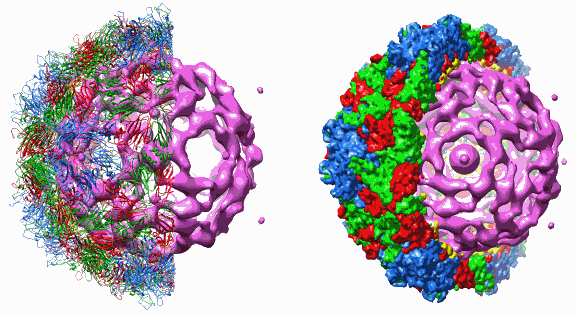The structure of the Senecavirus is also depicted at http://viperdb.scripps.edu/, the "Virus Particle Explorer" developed at Scripps Research by Reddy and his colleagues. The online database is a worldwide resource for information on the structure of viral particles; it contains details of 253 viruses to date.
The structure of a virus that is harmless to normal human cells but an enemy of certain cancer cells has been determined by researchers using an x-ray beamline at the U.S. Department of Energy’s Advanced Photon Source (APS) at Argonne National Laboratory. This new knowledge may help drug designers tweak the pathogen enough so that it can attack other tumor subtypes.
Using the University of Chicago’s BioCARS 14-ID beamline at the APS, the researchers from The Scripps Research Institute have, for the first time, solved the three-dimensional (3-D) structure of a virus, known as “Seneca Valley Virus-001,” that can infect specific cancer cells. The study was published in the journal Structure.
The 3-D structure reveals that the virus is unlike any other known member of the Picornaviridae viral family, confirms its recent designation as a separate genus "Senecavirus," and shows that the virus's outer protein shell looks like a craggy golf ball—one with uneven divots and raised spikes—and that the RNA strand beneath it is arranged in a round mesh rather like a whiffle ball.
"It is not at all like other known picornaviruses that we are familiar with, including poliovirus and rhinoviruses, which cause the common cold," says the study's senior author, Vijay S. Reddy of Scripps. "This crystal structure will now help us understand how Senecavirus works, and how we can take advantage of it."
The Senecavirus is a "new" virus, discovered several years ago by Neotropix Inc., a biotech company in Malvern, Pennsylvania. It was at first thought to be a laboratory contaminant, but researchers found it was a pathogen, now believed to originate from cows or pigs. Further investigation found that the virus was harmless to normal human cells, but could infect certain solid tumors, such as small-cell lung cancer, the most common form of lung cancer.
Scientists at Neotrophix say that, in laboratory and animal studies, the virus demonstrates cancer-killing specificity that is 10,000 times higher than that seen in traditional chemotherapeutics, with no overt toxicity. The company has developed the "oncolytic" virus as an anti-cancer agent and is already conducting early phase clinical trials on patients with lung cancer.
But the researchers still did not know how the virus worked, so they turned to Reddy. He and his Scripps Research team, especially Sangita Venkataraman, a postdoctoral researcher, determined the crystal structure of the Senecavirus.
Reddy describes the differences they found between other picornaviruses and the Senecavirus as being like variations among car models from the same manufacturer. "The chassis is the same, but the body style is different," he says. "How the body of a virus is shaped determines how it infects cells."
Once the structure of Seneca Valley Virus-001 was solved, researchers went on to identify several areas on the viral protein coat that they think might hook onto receptors on cancer cells in the process of infecting them. The researchers are now conducting further investigations on this process. "It will be critically important to find out what region of its structure the virus is using to bind to tumor cells, and what those cancer cell receptors are," Reddy says. "Then we can, hopefully, improve Senecavirus enough to make it a potent agent that can be used with many different cancers." — Renee Twombly
See: Sangita Venkataraman, Seshidhar P. Reddy, Jackie Loo, Neeraja Idamakanti, Paul L. Hallenbeck, and Vijay S. Reddy; “Structure of Seneca Valley Virus-001: An Oncolytic Picornavirus Representing a New Genus,” Structure 16, 1555 (08 October 2008). DOI: 10.1016/j.str.2008.07.013
This work was partially supported by the National Institutes of Health (NIH) Grant R56 AI070771 to V.S.R. Partial salary support to V.S.R. by NIH Research Resource Multiscale Modeling Tools for Structural Biology (MMTSB; RR12255) is acknowledged. BioCARS is an integral part of the multi-institutional and multi-disciplinary Center for Advanced Radiation Sources (CARS), managed by the University of Chicago.
The original news release can be found at: http://www.scripps.edu/news/press/2008/100808.html.
Use of the Advanced Photon Source at Argonne National Laboratory was supported by the U. S. Department of Energy, Office of Science, Office of Basic Energy Sciences, under Contract No. DE-AC02-06CH11357.
The nation's first national laboratory, Argonne conducts leading-edge basic and applied scientific research in virtually every scientific discipline. Argonne researchers work closely with researchers from hundreds of companies, universities, and federal, state and municipal agencies to help them solve their specific problems, advance America 's scientific leadership and prepare the nation for a better future. With employees from more than 60 nations, Argonne is managed by UChicago Argonne, LLC for the U.S. Department of Energy's Office of Science.

